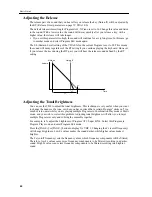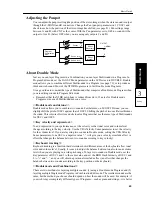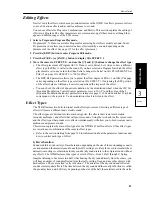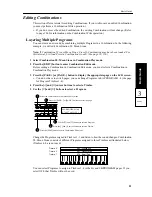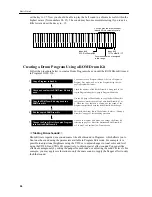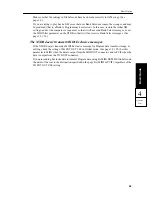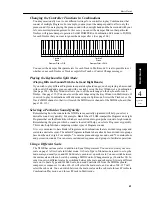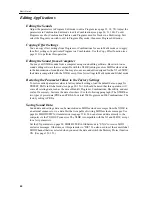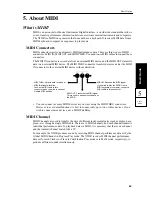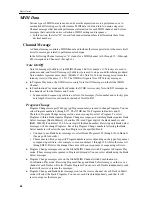
Basic Guide
55
Editing
3
Basic Guide
Changing Drum Sounds
As a default setting, drum sound 018: PicloSnare (the high-pitched sound of a thin-body snare) is
selected. Try to select various drum sounds and listen to them. Selecting --: No Assign allows you
to set an index that does not produce sound. For this example, select a powerful snare sound 022:
Ambi.Snare.
Changing the Assigned Key
Page 6B KEY/TUNE/L allows you to change the key assignment. Changing the default setting F2
allows you to change the key to which an index is assigned. You can select only the keys from A#1
and lower or A6 and higher. This is because the other keys have already been assighed to indexes
and you cannot assign multiple indexes to one key. (The keys not shown on the screen are already
assigned indexes.) If you wish to assign an index to a particular key, edit the index of that key or
change the key of the index. Avoid assigning indexes to the same key.
Altering the Tuning
You can change the pitch of drum sounds. The default value is +006, and the value can range from
–120 to +120 (1=10 cents). Altering the tuning will significantly change the nuances of a drum
sound. Raising or lowering the pitch radically can create special effects. Set this to about +30 to
obtain a clear sound, and to about –10 to obtain a powerful sound.
Changing the Level
The Level is adjusted for each index. You can adjust the entire volume level using the OSC Level
parameter in Program Edit mode or the VOLUME control on the front panel, but the volume level
balance of the index’s drum sound in a Drum Kit is adjusted by this parameter. The default value
+51 may produce a rather loud sound for the index we are now editing. Set the parameter to about
+10.
Changing the Decay
Now, go to 6C DECAY/ASGN. You can adjust the decay time (how long a sound sustains) using
the decay parameter. A higher value will produce a longer sustain, based on a value of 0.
Specifying a negative value will make the sound shorter. For example, adjusting the decay time is
very useful for a cymbal sound. Try a value of –25 to create a tight sound.
About the other parameters
The ASGN (Exclusive Assign) allows you to set an assigned group of indexes such that they will
cutoff each other’s sound. For example, the open hihat sound and the closed hihat sound should
not be triggered simultaneously. This parameter can be used for a whistle, guiro, shaker, or
triangle.
Page 6D PAN/SEND allows you to control how the sound is output for each index. The Pan
parameter determines the output balance between Output A and B, and the C and D parameters
determine the output level to C and D. The panpot setting specified in Global mode is effective in
Program Play mode, and each index uses its own panpot setting. If you set the panpot parameter
to PRG in Combination Play mode or Multi mode, each index uses its own panpot setting. (See
page 105, 109.)
Playing a Chromatic Scale Using a Single Drum Sound
As described earlier, you can assign the drum sounds in a Drum Kit to different keys. In a similar
way, you can also play a chromatic scale using a single drum sound. The example described below
is a bell sound.
Since the indexes of Drum Kit 1 are already assigned to the entire keyboard as a default setting,
first you need to set drum sounds of indexes #50–#59 to --: No assign, and set the key of index #59
to any key other than C7. At this point, no index should be assigned to the highest octave keys on
the keyboard (no sound will be produced within this range.) Set Index #40 to 137: TubulBell2, and
Содержание X5DR AI2 SYNTHESIS MODULE
Страница 1: ...GENERAL INSTRUMENT AI 2 SynthesisSystem 1 E Owner s Manual AI 2 SYNTHESIS MODULE ...
Страница 7: ...Controls vi ...
Страница 13: ...About this manual xii ...
Страница 156: ...Reference Guide 143 Reference Guide Effect Parameters 4 ...


